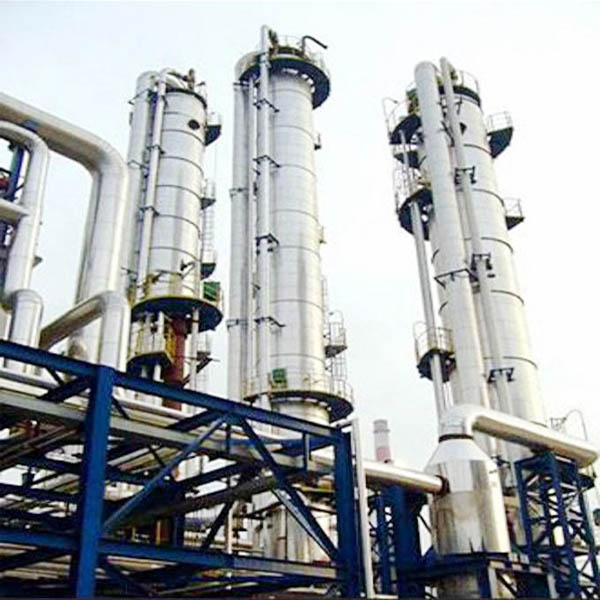A Comprehensive Analysis of the Working Principle and Industrial Applications of Extraction Towers: A Guide to the Core Equipment of High - Efficiency Separation Technology
Release time:2025-08-30
Visits:148
In industrial fields such as chemical engineering, pharmaceuticals, and environmental protection, the extraction tower, as a core liquid - liquid mass transfer device, has become an indispensable technological equipment in modern industrial production due to its high - efficiency component separation ability. Through the selective dissolution characteristics of two immiscible liquids, it enables the precise purification and recovery of target components, helping enterprises optimize resource utilization and improve product quality.
I. Working Principle and Technological Evolution of Extraction Towers
The extraction tower is based on the principle of liquid - liquid counter - current mass transfer. Through the full contact of two phases (extractant and raw material liquid), separation is achieved by utilizing the solubility difference of the target component in the two liquids. Traditional equipment such as packed towers and plate towers rely on gravity or mechanical dispersion for mass transfer, while the new turbine extraction tower generates strong shear force through a high - speed rotating moving ring, dispersing the liquid into micron - sized droplets, significantly improving the mass transfer efficiency [Reference content]. The technological evolution directions include modular design, real - time monitoring of the phase interface, and the integration of intelligent control systems, further enhancing the adaptability and separation accuracy of the equipment.
1. Packed Tower: It is equipped with packing with a high specific surface area (such as ceramic rings and metal wire mesh), and is suitable for continuous operation scenarios with medium separation requirements, such as solvent recovery in the petrochemical industry.
2. Rotating Disc Tower (Turbine Extraction Tower): With a moving ring - stationary ring combined structure, it accelerates phase separation through centrifugal force. It can handle high - viscosity materials and low - concentration systems, and is widely used in the purification of pharmaceutical intermediates and the treatment of phenol - containing wastewater.
3. Pulsed Extraction Tower: By periodically inputting energy through pulses, it enhances the mixing efficiency of the two phases and is suitable for the gentle separation of heat - sensitive substances.
4. Spray Tower: It has a simple structure and large processing capacity, and is suitable for the pretreatment or initial separation stage.
III. Industrial Application Cases and Benefit Analysis
- Pharmaceutical Industry: In the production of antibiotics (such as penicillin), the single - extraction purity of the turbine extraction tower can reach over 99%, reducing the subsequent refining cost.
- Petrochemical Industry: It is used for the separation of aromatics and alkanes to improve the quality of fuel. In the natural gas desulfurization process, the recovery rate exceeds 95%, reducing environmental pollution.
- Environmental Governance: When treating heavy - metal - containing wastewater, the extraction tower can directionally recover valuable components such as copper and nickel, realizing resource recycling.
- Food Processing: For the low - temperature extraction of natural flavors (such as rose essential oil), it retains the active components while avoiding thermal decomposition losses.
IV. Key Consideration Factors for Design and Selection
1. Selection of Extractant: It is necessary to consider selectivity, stability, and economy. For example, the pharmaceutical industry prefers to use food - grade solvents.
2. Optimization of Operating Parameters: Parameters such as temperature, flow ratio, and rotation speed (for turbine towers) directly affect the mass transfer efficiency. The optimal combination needs to be determined through CFD simulation and experimental verification.
3. Anti - clogging Design: For high - solid - content systems, a convex filter screen or self - cleaning structure is used to reduce the frequency of shutdown maintenance.
4. Corrosion Resistance of Materials: When dealing with acidic media, Hastelloy or graphite - lined materials can be selected to extend the service life of the equipment.
V. Comparison of Technological Advantages and Limitations
Advantages:
- High separation efficiency (the single - extraction purity of the turbine tower is > 99.9%).
- Low energy consumption (closed - loop operation reduces solvent evaporation losses).
- Strong adaptability (it can handle high - viscosity and heat - sensitive materials).
Limitations:
- High initial investment (due to the processing cost of the precision moving ring system).
- Sensitive to emulsified systems (pre - demulsification or the addition of a centrifugal separation module is required).
- Difficulty in extractant regeneration (in some scenarios, a distillation unit needs to be installed).
VI. Outlook on Industry Development Trends
With the penetration of intelligent manufacturing technology, intelligent extraction towers are becoming a new direction in the industry. For example, integrating IoT sensors to monitor phase interface changes in real - time and combining AI algorithms to dynamically adjust the rotation speed and flow rate; modular skid - mounted design shortens the commissioning cycle to meet the flexible needs of small and medium - sized enterprises. Driven by environmental protection policies, the demand for extraction towers in emerging fields such as the recovery of metals from waste lithium - ion batteries and carbon dioxide capture will continue to grow.

